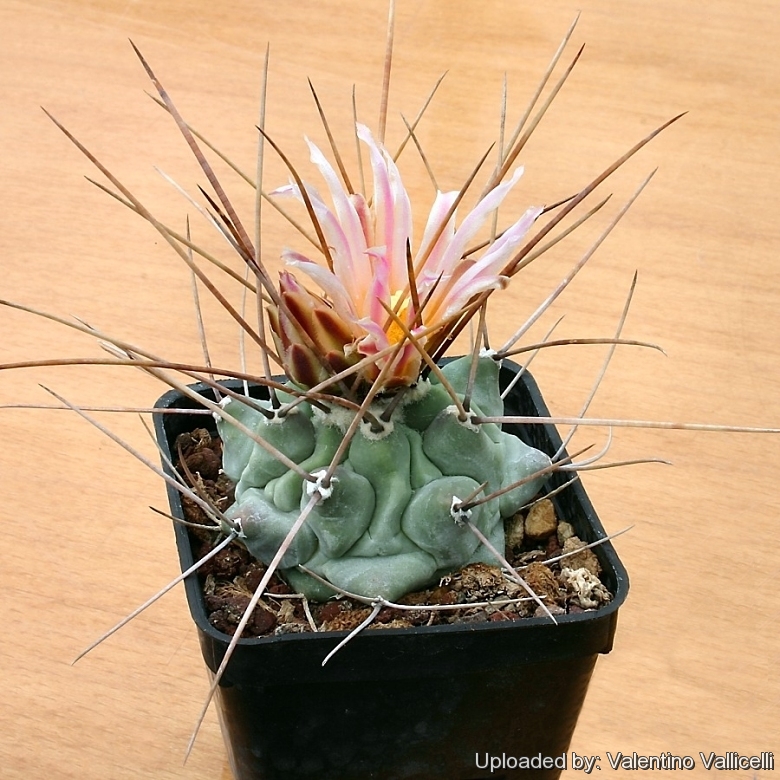
Thelocactus rinconensis Photo by: Valentino Vallicelli
SB301 Rinconada, Nuevo Leon, Mexico. The remarkable characteristics of this species are a depressed and glaucous body and very long spines.
Origin and Habitat: It occurs in Coahuila and Nuevo Leon, Mexico.
Altitude: 1200-1900 metres above sea level.
Habitat: It is widespread and quite common in the Chihuahuan Desert in xerophytic shrubland on calcareous soils. There are no major threats to this species, although the habitat is overgrazed by goats.
Synonyms:
See all synonyms of Thelocactus rinconensis
Common Names include:
SPANISH (Español): Biznaga pezón de la rinconada
Description: Thelocactus rinconensisSN|10887]]SN|10887]] is one of the most decorative cacti of the deserts of Mexico and extremely variable in its spines. Thelocactus rinconensisSN|10887]]SN|10887]] has received many unnecessary infraspecific epithets, and in cultivation it is commonly found under its three varieties, the type and var. nidulans with long spines, var. phymatothele with very short spines, but the only acceptable distinction is Thelocactus rinconensisSN|10887]]SN|10887]] subsp. hintonii, which occurs in Nuevo Leon at some distance from the main population.
Habit: Usually solitary, develops a squat and highly ribbed stem with a flattened top.
Stem: Spherical or somewhat depressed 4-15 cm tall, 9-20 cm across. It can have either a light glaucous-grey or green epidermis sometimes tinged with purple.
Ribs: 20 to 31, rather indistinct, divided into strong tubercles.
Tubercles: Conical, angled quite pointed, elongate toward the tip but flattened on top,12-27 mm long, 7-15 mm wide, 8-15 mm high.
Areoles: Round to elongate, mostly more than 2 cm apart and without nectaries.
Spines: Sometimes absent, very variable in length, depending on the clone, dark, usually black-brown , pale at apex, but also grey, brown or yellow, with a distinctive silvery appearance, and sometimes shredding.
Central spines: 0-4 straight, terete to angled, sometimes scaly with age, variable in length very short or to 6 (or more) cm long.
Radial spines: 0-5 very similar to the centrals, erect to radiating, straight 3-35(-50) mm long.
Flowers: 3-5 cm long, 2,7-3 cm in diameter, salmon-pink or whitish, often yellowish in the throat, or occasionally yellowish or magenta with a dark midvein. Tube short, pericarpels covered
with scales. The plants usually fail to flower until they are 5-9 years old.
Fruit: Spherical ta oblong with scales, 7-9 mm in diameter, greenish or yellowish, slightly fleshy when ripe, opening by basal pore.
Seeds: 1,7-2 mm long, 0,5-1 mm broad, net-patterned with polygonal or square areas.
Subspecies, varieties, forms and cultivars of plants belonging to the Thelocactus rinconensis group
 Thelocactus rinconensis (Poselg.) Britton & Rose: has a squat and highly ribbed, glaucous-grey, stem, sometimes tinged with purple. it is extremely variable in its spines. Distribution: Coahuila and Nuevo Leon.
Thelocactus rinconensis (Poselg.) Britton & Rose: has a squat and highly ribbed, glaucous-grey, stem, sometimes tinged with purple. it is extremely variable in its spines. Distribution: Coahuila and Nuevo Leon. Thelocactus rinconensis subs. freudenbergeri (R.Haas) Mosco & Zanov.: This subspecies differs from the type for the presence of acicular radial spines and the beautiful magenta flowers. Distribution: Nuevo León, near Grutas de Garcia.
Thelocactus rinconensis subs. freudenbergeri (R.Haas) Mosco & Zanov.: This subspecies differs from the type for the presence of acicular radial spines and the beautiful magenta flowers. Distribution: Nuevo León, near Grutas de Garcia. Thelocactus rinconensis var. lophothele hort.: vigorous plant solitary or sprouting at the base with ribs thickened at intervals into tubercles. Radial spines finer, central spines clearly different long. Distribution:Saltillo, Coahuila.
Thelocactus rinconensis var. lophothele hort.: vigorous plant solitary or sprouting at the base with ribs thickened at intervals into tubercles. Radial spines finer, central spines clearly different long. Distribution:Saltillo, Coahuila. Thelocactus rinconensis subs. nidulans (Quehl) Glass: has long spines so grouped and arranged that they look like a bird s nest. Distribution: Coahuila, particularly around Saltillo and Parras.
Thelocactus rinconensis subs. nidulans (Quehl) Glass: has long spines so grouped and arranged that they look like a bird s nest. Distribution: Coahuila, particularly around Saltillo and Parras. Thelocactus rinconensis subs. palomaensis Pavlíček & Zatloukal: stem up to 250 Ø silvery green. Ribs 13 , deeply divided into tubercle with blunt keel. Central spines 2-4, brownish up to 80 mm long, radials 4-11 yellowish and glassy. Distribution: Northern border of the Sierra Paila, Coahuila
Thelocactus rinconensis subs. palomaensis Pavlíček & Zatloukal: stem up to 250 Ø silvery green. Ribs 13 , deeply divided into tubercle with blunt keel. Central spines 2-4, brownish up to 80 mm long, radials 4-11 yellowish and glassy. Distribution: Northern border of the Sierra Paila, Coahuila Thelocactus rinconensis subs. phymatothelos (Poselg.) Glass: stem is always strongly depressed and glaucous, the spines are shorter and slightly curved, and the flowers are more or less clear pink. Distribution: Arteaga and Saltillo, Coahuila.
Thelocactus rinconensis subs. phymatothelos (Poselg.) Glass: stem is always strongly depressed and glaucous, the spines are shorter and slightly curved, and the flowers are more or less clear pink. Distribution: Arteaga and Saltillo, Coahuila.
Bibliography: Major references and further lectures
1) Edward Anderson “The Cactus family” Timber Press, Incorporated, 2001
2) James Cullen, Sabina G. Knees, H. Suzanne Cubey "The European Garden Flora Flowering Plants: A Manual for the Identification of Plants Cultivated in Europe, Both Out-of-Doors and Under Glass" Cambridge University Press, 11/Aug/2011
3) David R Hunt; Nigel P Taylor; Graham Charles; International Cactaceae Systematics Group. "The New Cactus Lexicon" dh books, 2006
4) Urs Eggli, Leonard E. Newton: “Etymological Dictionary of Succulent Plant Names” Springer, Berlin/Heidelberg 2010
5) Philip Perl “Cacti and succulents” 1978
6) N. L. Britton, J. N. Rose: “The Cactaceae. Descriptions and Illustrations of Plants of the Cactus Family.” Volume III, The Carnegie Institution of Washington, Washington 1922
7) Hans Hecht “BLV-Handbuch der Kakteen” BLV-Verlagsgesellschaft, 1982
8) E Haustein “Der Kosmos Kakteenfuehrer (the Kosmos Cactus Guide)” Balogh Scientific Books 01 December 1998
9) Paul Carpenter Standley “Trees and shrubs of Mexico, Parti 1-3” Govt. Print. Off., 1926
10) Edgar Lamb, Brian Lamb “The Illustrated Reference on Cacti & Other Succulents, Volume 5” Blandford Press, 1978
11) Clive Innes “Complete Handbook of Cacti and Succulents” Van Nostrand Reinhold Company, 01/Dec/1981
12) Walther Haage “Cacti and succulents: a practical handbook” Dutton, 1963
13) A. J. van Laren, Scott Edson Haselton “Cactus” Abbey San Encino Press, 1935
14) Gordon D. Rowley “The illustrated encyclopedia of succulents” Crown Publishers, 01/Aug/1978
15) Hans Hecht “Cacti & Succulents” Sterling Publishing Company Incorporated, 1994
16) Roger Spencer "Horticultural Flora of South-eastern Australia: The Identification of Garden and Cultivated Plants. Flowering plants : Dicotyledons, Volume 2, Parte 1” UNSW Press, 1997
17) John Pilbeam “Cacti for the Connoisseur: A Guide for Growers & Collectors” Timber Press, 01/Jul/1987
18) Gómez-Hinostrosa, C., Hernández, H.M., Sotomayor, M. & Smith, M. 2013. Thelocactus rinconensis. In: IUCN 2013. "IUCN Red List of Threatened Species." Version 2013.2. <www.iucnredlist.org>. Downloaded on 26 November 2013.
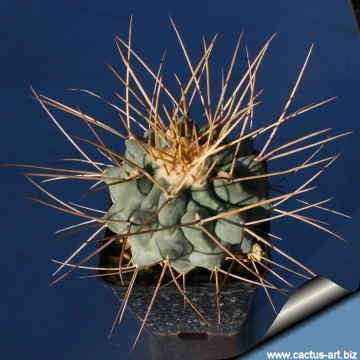 Thelocactus rinconensis Photo by: Cactus Art
Thelocactus rinconensis Photo by: Cactus Art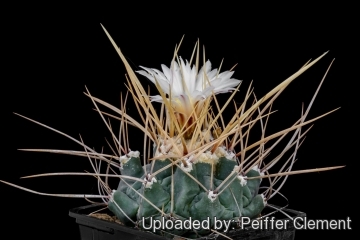 Thelocactus rinconensis Photo by: Peiffer Clement
Thelocactus rinconensis Photo by: Peiffer Clement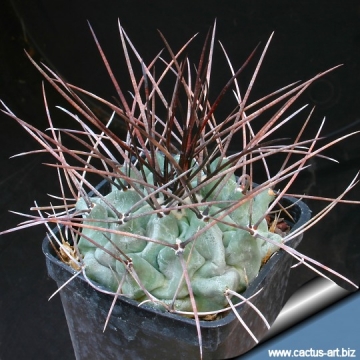 Thelocactus rinconensis Photo by: Cactus Art
Thelocactus rinconensis Photo by: Cactus Art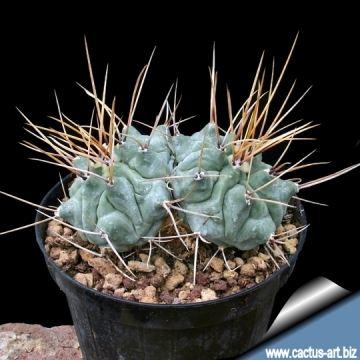 Thelocactus rinconensis Photo by: Cactus Art
Thelocactus rinconensis Photo by: Cactus ArtCultivation and Propagation: Thelocactus rinconensisSN|10887]]SN|10887]] is a summer grower species easy to cultivate.
Growth rate: It is a slow growing species.
Soil: Use mineral well permeable substratum with little organic matter (peat, humus), plants may become too elongated if compost is too rich.
Repotting: Re-pot every 2 years. Use pot with good drainage.
Fertilization: It grows much faster with a low nitrogen content fertilizer in spring and summer.
Watering: Requires careful watering to keep plant compact. Water sparingly from March till October, the thin, fibrous roots suffer if there is humidity, therefore the plant should be watered only when the surrounding terrain is dry. Keep dry as soon as the temperature starts dropping in October and keep it perfectly dry in winter at temperatures from 5 to 15 degrees centigrade.
Hardiness: They need to be kept in a cool place during winter rest and are somewhat resistant to frost if kept on the dry side prior to, and during, cold weather ( they are hardy to -5 C ° C or less for short periods). Although it is one of the easier cacti to grow, it tends to rot in winter during the resting phase, if kept wet. In the rest period no high atmospheric humidity!!
Sun Exposure: Requires full sun in winter and some protection in summer, its colour tends to richer and darker when grown in light shade.
Uses: It is an excellent plant for container growing. It always looks good and stays small.
Pests & diseases: It may be attractive to a variety of insects, but plants in good condition should be nearly pest-free, particularly if they are grown in a mineral potting-mix, with good exposure and ventilation. Nonetheless, there are several pests to watch for:
- Red spiders: Red spiders may be effectively rubbed up by watering the infested plants from above.
- Mealy bugs: Mealy bugs occasionally develop aerial into the new growth among the wool with disfiguring results, but the worst types develop underground on the roots and are invisible except by their effects.
- Scales: Scales are rarely a problem.
- Rot: Rot is only a minor problem with cacti if the plants are watered and “aired” correctly. If they are not, fungicides won't help all that much. To prevent rottenness it is also advisable to surround its root neck by very rough sand or grit, this help a fast water drainage.
Propagation: Nearly always from seed, since the plant rarely produces plantlets.















